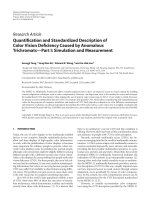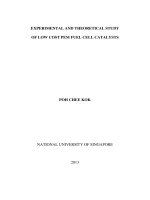Isolation and microscopic study of leaf spot of chromolaena odorata (Siam Weed) caused by Phytophthora spp. from Tripura
Bạn đang xem bản rút gọn của tài liệu. Xem và tải ngay bản đầy đủ của tài liệu tại đây (488 KB, 5 trang )
Int.J.Curr.Microbiol.App.Sci (2019) 8(4): 2323-2327
International Journal of Current Microbiology and Applied Sciences
ISSN: 2319-7706 Volume 8 Number 04 (2019)
Journal homepage:
Original Research Article
/>
Isolation and Microscopic Study of Leaf Spot of Chromolaena odorata
(Siam Weed) caused by Phytophthora spp. from Tripura
Durga Prasad Awasthi1 and Sumen Kapali2*
1
2
Department of Plant Pathology, College of Agriculture, Tripura, India
Vocational Education Teacher (Agriculture), SIBIN Group, Kamalghat Higher Secondary
School, India
*Corresponding author
ABSTRACT
Keywords
Asteraceae,
Sporangia,
Sporangiophores,
Monochasium,
Dichasium
Article Info
Accepted:
17 March 2019
Available Online:
10 April 2019
To explore bio-control options available for management of Siam weed, a survey was
conducted during the year 2017-18 and 2018-19 in different districts of Tripura, India.
During survey, symptoms of leaf blight were observed on leaves of Siam weed. Fungi
isolated from infected sample on PDA media shows slow growth covering whole petri
plate within 10 days. During incubation period fungal sporulation increases with increase
in growth period. Identification of suspected causal agent was Phytophthora which was
confirmed based on the morphology. Culture colonies of Phytophthora produce coenocytic
hyphae, unbranched sporangiophores, ovoid or subglobose to globose hyphal swellings
with an average diameter of 18.6 ± 6.5 μm. Pathogenicity tests were carried out for further
confirmation. Based on morphological features, the fungus on Siam weed was identified as
Phytophthora spp. Based on available reviews, this is the first incidence of report of
Phytophthora spp. from Tripura under the family Asteraceae, causing Leaf blight on Siam
weed.
Introduction
Siam weed (Chromolaena odorata & C.
squalida), looks similar to Blue top or Billy
goat weed (Ageratum spp.), mature plants
have a growth habit similar to Lantana
(Lantana camara).
Chromolaena odorata has become one of the
worst terrestrial invasive plants in the humid
tropics and northeastern India (Waterhouse,
1994). It contains very high nitrate levels and
may also cause skin complaints and asthma in
allergy-prone people (Prasad et al., 2005,
Koutika et al., 2010).
To explore bio-control options available for
its management a survey was conducted
during the year 2017-18 and 2018-19 in
different districts of Tripura. The present
study revealed incidence and occurrence of
Phytophthora species causing leaf spot of
Siam weed under Agro-climatic condition of
Tripura.
2323
Int.J.Curr.Microbiol.App.Sci (2019) 8(4): 2323-2327
Materials and Methods
During the year 2017-18 and 2018-19, a
routine survey on plants of Siam weed was
conducted in the different Districts of Tripura,
India namely, Gomati, Siphahijala, Khowai,
west, South, Dhalai, Unokoti, and North
Tripura. In vivo observation of disease
symptoms were carried out, time of
occurrence of disease, plant part affected and
development process was recorded at regular
interval. Samples were brought into the
laboratory and compared with standard
Disease Atlas and Books. Pathogen concern is
isolated aseptically in Potato Dextrose Agar
(PDA) slants. Before isolation small bits from
the diseased plant parts were cut and washed
in running tap water followed by washing in
distilled water. The washed samples were
then dipped in 0.1% HgCl2 (Mercuric
Chloride) solution for 30 to 45 seconds for
surface sterilization and then washed in sterile
distilled water. The PDA slants were then
incubated at 28 1C in B.O.D. incubator for
14 days. Further sub culturing was carried out
by taking 6 mm discs. The isolated fungus
was inoculated into healthy plants grown in
pots for confirmation of Koch postulates.
Leaves sample and isolated fungi were
mounted in Canada balsam and stained with
cotton blue. For taxonomic identification, the
morphology of obtained isolates was
examined at 10 X, 40 X and 100 X
magnifications. Colony growth patterns were
examined at incubating the pathogen for one
week at 20 ◦C in the dark on agar media.
Results and Discussion
In vivo observation of affected leaves initially
show small dark spots which enlarge rapidly
and turn purplish brown at the margins and
tips of the leaf (Fig. 1). As the disease
progresses, the lesions (mostly along the leaf
margin) continue to expand and frequently
coalesce. The boundary between the healthy
and diseased tissues is usually indistinct and
smooth. The morphology of Phytophthora
spp. was examined at 10 X, 40 X and 100 X
magnifications using a light microscope, the
result revealed that the sexual morph of this
fungus was absent. Culture colonies of
Phytophthora isolates on the PDA medium
(Fig. 2) shows creamy white, wooly slow
growth fungi. At initial level Primary hyphae
grows slowly often branching in a mono- or
dichasium with the mother hypha ending in a
short protruding tip largely submerged with
limited felty aerial mycelium ( Fig. 3 and 4).
Initially, Sporangia were not observed on
solid agar but are produced abundantly after
24 hours in the same agar plate, borne
terminally on unbranched sporangiophores,
non-caducous, and papillate (Fig. 5 and 6),
ovoid or subglobose to globose and irregular
hyphal swellings (Fig. 7 and 8 ) with an
average diameter of 18.6 ± 6.5 μm produced
abundantly. Chlamydospores were not
observed. The morphological and microscopic
study confirms the asexual morph of
Phytophthora spp as causal organisum of leaf
spot of Siam weed. The pathogen is readily
identified as an asexual morph of the genus
Phytophthora which are according to the
findings of Andre and Sendall, 2001; Goheen
et al., 2007; Latham et al., 2015). In future
course of study molecular sequence analyses
need to be taken up for further confirmation.
In the pathogenicity test, inoculated leaves
developed leaf spots symptoms 10 days after
inoculation, where the control leaves
remained healthy. The fungus present on the
inoculated leaves was morphologically
identical to that originally observed on
disease plants.
Although no prominent report so far has been
recorded about the incidence of Phytophthora
in Siam weed from Tripura. The Siam weed
belongs to the family Asteraceae it includes
Aster,
Dahlia,
Marigold,
Safflower,
2324
Int.J.Curr.Microbiol.App.Sci (2019) 8(4): 2323-2327
Sunflower, Stevia, Znnia etc. Phytophthora
Susceptible hosts includes the members of the
Asteraceae,
Ranunculaceae,
Lamiaceae,
Rhamnaceae, Phrymaceae, Rosaceae, and
Verbenaceae plant families (Latham et al.,
2015). Chromolaena odorata belongs to the
Asteraceae (Compositae), a large, welldefined and highly evolved family (Toelken,
1983; Bremer, 1994; APG II, 2003) (Table 1).
Table.1 In vivo observation of disease symptoms, time of occurrence of disease, plant part
affected and pathogen stages recorded
Sl.No.
1
2
Plant Part affected
Leaves
Stems (above ground)
Visibility of the symptoms
Usually visible to the naked eye
Usually visible to the naked eye
Time of Occurrence
June-February
Fig.1 1.Phytophthora infected Siam Weed, 2. Culture of Phytophthora on PDA, 3. 4., Hyphae
initially with slow growth branching with the hypha ending in a short protruding tip (10 X), 5.,
6., Sporangia terminally on unbranched sporangiophores, non-caducous, and non-papillate
(40 X), 7., 8., Sporangia ovoid or subglobose to globose or Non papilate (100 X)
2325
Int.J.Curr.Microbiol.App.Sci (2019) 8(4): 2323-2327
Siam weed mainly of the tropics and
subtropics, many of the countries in which it
is a problem do not have the resources to
implement comprehensive control programs
using conventional methods. Consequently,
biological control has become an important
management tool (Boller et al., 2006).
Research into the potential of biological
control for C. odorata through Phytophthora
presumably used as a biological agent to keep
it under control.
clues for identification. Chlamydospores were
not observed. Sporangia are borne terminally
on unbranched sporangiophores, noncaducous, papillate, ovoid, subglobose to
globose with irregular hyphal swellings
having average diameter of 18.6 ± 6.5 μm.
This confirmed the fungi as asexual morph of
Phytophthora spp. having high potential for
exploring it as bio-control agent against Siam
weed management.
References
In conclusion, the pathogen produced
purplish-brown, blackish water soaked lesions
seen on margin of the leaves. Sporulation in
Phytophthora cultures provides important
Boller, E. F., van Lanteren, J. C. and
Delucchi, V. (2006). International
Organization for Biological Control of
2326
Int.J.Curr.Microbiol.App.Sci (2019) 8(4): 2323-2327
Noxious Animals and Plants. History of
the First 50 Years (1956–2006). IOBC,
Zurich, Switzerland, Pp. 275.
Bremer, K. (1994). Asteraceae – Cladistics
and Classification. Portland, OR:
Timber Press. APG II (2003). An
update of the Angiosperm Phylogeny
Group classification for the orders and
families of flowering plants: APG II.
Botanical Journal of the Linnean
Society, 141, 399–436.
Drenth, A., and Sendall, B., (2001). Practical
guide to detection and identification of
Phytophthora, CRC for Tropical Plant
Protection Brisbane Australia.
Goheen, E. M. and Frankel, S. J., (2007).
Phytophthoras in Forests and Natural
Ecosystems, Proceedings of the Fourth
Meeting of the International Union of
Forest Research Organizations (IUFRO)
Working Party, Monterey, California.
Koutika, L., Rainey, S. H.J. (2010).
Chromolaena odorata in different
ecosystems: weed or fallow plant.
Applied Ecology and Environmental
Research. 8(2): 131-142.
Latham, R., Blomquist, S., Swiecki,C.L. and
Bernhardt, E. (2015). Phytophthora
tentaculata. Forest Phytophthoras 5(1).
Prasad, Narayana, S., Jayakumar, K.,
Srikanth, K.G., (2005). Phytochemical
Analysis of Toxic Plant Chromolaena
odorata
(Eupatorium
odoratum).
Journal of the Indian Society of
Toxicology, 1:1.
Toelken, H. R. (1983). Compositae. In
Flowering Plants in Australia, ed. B. D.
Morley and H. R. Toelken. Adelaide,
Australia: Rigby, Pp. 300–314.
Waterhouse, D. F. (1994b). Biological
Control of Weeds: Southeast Asian
Prospects. ACIAR Monograph, 26: 1–
302.
How to cite this article:
Durga Prasad Awasthi and Sumen Kapali. 2019. Isolation and Microscopic Study of Leaf Spot
of Chromolaena odorata (Siam Weed) caused by Phytophthora spp. from Tripura.
Int.J.Curr.Microbiol.App.Sci. 8(04): 2323-2327. doi: />
2327









